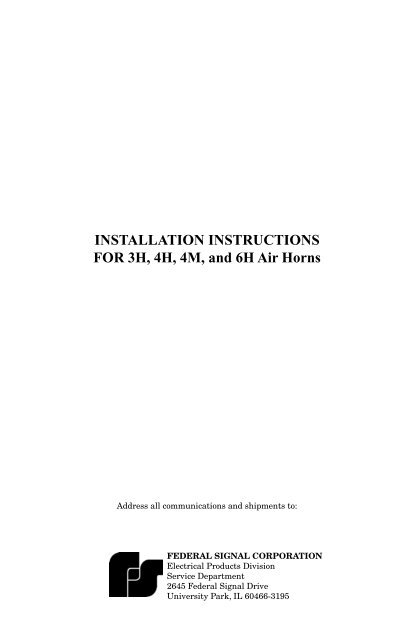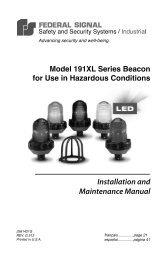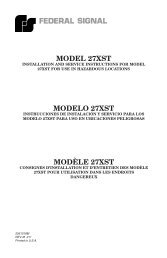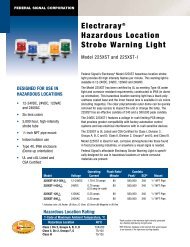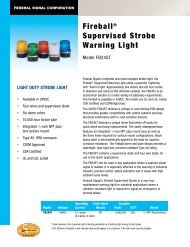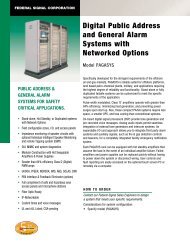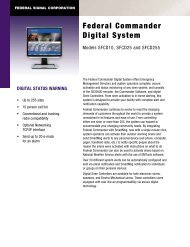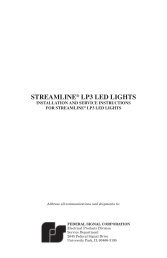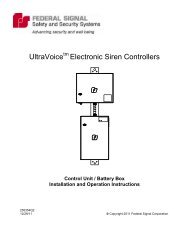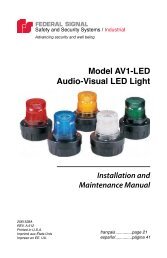3H-6H Air Horn - Federal Signal
3H-6H Air Horn - Federal Signal
3H-6H Air Horn - Federal Signal
You also want an ePaper? Increase the reach of your titles
YUMPU automatically turns print PDFs into web optimized ePapers that Google loves.
INSTALLATION INSTRUCTIONS<br />
FOR <strong>3H</strong>, 4H, 4M, and <strong>6H</strong> <strong>Air</strong> <strong>Horn</strong>s<br />
Address all communications and shipments to:<br />
FEDERAL SIGNAL CORPORATION<br />
Electrical Products Division<br />
Service Department<br />
2645 <strong>Federal</strong> <strong>Signal</strong> Drive<br />
University Park, IL 60466-3195
INSTALLATION INSTRUCTIONS<br />
FOR<br />
<strong>3H</strong>, 4H, 4M, AND <strong>6H</strong> AIR HORNS<br />
SAFETY MESSAGE TO INSTALLERS<br />
People’s lives depend on your safe installation of our products. It is important to<br />
follow all instructions shipped with the products. This device is to be installed by<br />
qualified personnel who are trained in pipefitting and electrical wiring, and are<br />
familiar with national as well as local codes.<br />
The selection of the mounting location for the device, its controls and routing of<br />
the pipe is to be accomplished under the direction of the facilities engineer and the<br />
safety engineer. In addition, listed below are some other important safety instructions<br />
and precautions you should follow:<br />
• Read and understand all instructions before installing or operating this<br />
equipment.<br />
• Optimum sound distribution will be severely reduced if any objects are<br />
in front of the horn. You should ensure that the front of the horn is clear<br />
of any obstructions.<br />
• All effective warning horns produce loud sounds which may cause, in<br />
certain situations, permanent hearing loss. You should take appropriate<br />
precautions such as wearing hearing protection when testing the horn.<br />
• After installation, ensure that all bolts and threaded joints have been<br />
tightened.<br />
• Establish a procedure to routinely check the sound system for proper<br />
activation and operation.<br />
• Provide a copy of these instructions to the safety Engineer, operator(s),<br />
and maintenance personnel.<br />
• File these instructions in a safe place and refer to them when maintaining<br />
and/or reinstalling the device.<br />
• Failure to follow all safety precautions and instructions may result in<br />
property damage, serious injury, or death to you or others.<br />
A. GENERAL.<br />
These air horns utilize stainless steel diaphragms and corrosion resistant castings<br />
finished with a gray polyester coating. They are capable of being operated on air<br />
pressure of 20 to 150 p.s.i.g., but are tuned for optimum audibility at 80 to 90 p.s.i.g.<br />
The Model <strong>3H</strong> horn is tuned to a frequency of 750Hz. It has a female 3/8 I.P.S<br />
threaded opening for connection to the compressed air system, and is light enough to be<br />
supported by the pipe to which it is connected.<br />
The Model 4H horn is tuned to 450Hz and the Model 4M horn is tuned to 340Hz.<br />
Both horns have a female 1/2 I.P.S. threaded opening for connection to the compressed<br />
air system, and are provided with a mounting ear on each side of the casting that<br />
includes a hole for 5/16 inch bolts.<br />
-1-
The Model <strong>6H</strong> horn is tuned to a frequency of 295Hz. It has a female 3/4 I.P.S.<br />
threaded opening for connection to the compressed air system and is provided with a<br />
mounting ear on top of the casting that includes two mounting holes for 1/2 inch bolts.<br />
It also contains a mounting flange around the pipe opening with four mounting holes<br />
for 1/2 inch bolts.<br />
B. INSTALLATION.<br />
1. Determine the location of the horn and air valve, and layout the airline to<br />
them from the air source. For optimum performance the air line should be as short<br />
and as straight as possible. Angles and bends should be avoided as much as possible,<br />
but where unavoidable, it is recommended that long sweep elbows be used to maximize<br />
air flow to the horn.<br />
NOTE<br />
The valve to actuate the horn should be located as close to the horn as<br />
possible. The farther it is located from the horn the longer it will take to<br />
obtain full volume when activated and the longer it will take to stop sounding<br />
when deactivated.<br />
2. Before attaching the horn to the air line, blow out the air line to remove any<br />
debris that may have accumulated during assembly. Failure to do so may cause the<br />
debris to become lodged in the air valve or between the horn’s diaphragm and body<br />
which will restrict movement of the diaphragm and significantly affect horn performance.<br />
3. It is recommended that a pipe union be used when connecting the horn and<br />
air valve to the air line. This will allow for easier removal of the horn and air valve<br />
should service be required.<br />
C. OPERATION.<br />
WARNING<br />
These horns produce very loud sounds. Appropriate hearing protection<br />
should be worn while verifying horn operation.<br />
Operate the air valve and verify that the horn sounds. Also verify that the sound<br />
is smooth with no distortion. Release the air valve.<br />
-2-
SAFETY MESSAGE TO MAINTENANCE PERSONNEL<br />
• Read and understand all instructions before performing any maintenance<br />
to this unit.<br />
• Optimum sound distribution will be reduced if the horn becomes clogged<br />
with a foreign substance. Periodic checks should be performed to ensure<br />
foreign substances are not packed into horn.<br />
• Any maintenance must be performed by qualified personnel trained in<br />
pipe fitting and electrical wiring in accordance with national and local codes.<br />
• Never alter the unit in any manner. Safety in hazardous locations may<br />
be endangered if additional openings, or alterations are made to the unit in<br />
these locations.<br />
Failure to follow all safety precautions and instructions may result in property<br />
damage, serious injury, or death to you or others.<br />
D. REPLACEMENT PARTS.<br />
Description Part Number<br />
Retaining Ring, <strong>3H</strong> K8271A009<br />
Retaining Ring, 4H K8271A011<br />
Retaining Ring, 4M K8271A034<br />
Retaining Ring, <strong>6H</strong> K8271C023<br />
Diaphragm, <strong>3H</strong> K8271A020<br />
Diaphragm, 4H K8271A013<br />
Diaphragm, 4M K8271A072<br />
Diaphragm, <strong>6H</strong> K8271A077<br />
Locking Screw, <strong>3H</strong>, 4H, 4M K7000A070-16<br />
Locking Screw, <strong>6H</strong> K7002A046-12<br />
Jam Nut, <strong>3H</strong>, 4H, 4M K7059A016<br />
-3-
E. SPECIFICATIONS.<br />
Model Pipe Size <strong>Air</strong> Consumption Frequency dBA@<br />
(in.) (cubic ft/sec) (Hz) 10 ft.<br />
<strong>3H</strong> 3/8 0.2 750 112<br />
4H 1/2 0.25 450 117<br />
4M 1/2 0.25 340 117<br />
<strong>6H</strong> 3/4 0.45 295 122<br />
Model Dimensions (in) Weight <strong>Air</strong> Valve to<br />
A B C (lbs) Be Used<br />
<strong>3H</strong> 4-7/8 4-3/4 3-7/8 3.5 EVS<br />
4H 7-7/8 5-5/8 5 5 EVM<br />
4M 11-1/4 5-9/16 5 7.5 EVM<br />
<strong>6H</strong> 12-3/8 9-1/2 2-3/16 21 EVL<br />
B<br />
B<br />
C<br />
A<br />
A<br />
A<br />
3" HORNS<br />
4" HORNS<br />
B<br />
6" HORNS C<br />
290A4401<br />
-4-<br />
C<br />
C
2561771A<br />
REV. A 1201<br />
Printed in U.S.A.


